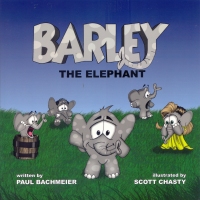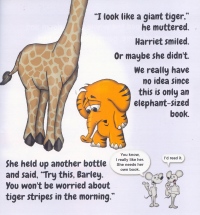| ________________
CM . . .
. Volume XXI Number 4 . . . . September 26, 2014
excerpt:
Feeling like an outcast or an “Ugly Duckling” because of some type of physical difference is an oft-used theme in children’s literature. Author Bachmeier, with the hilarious visual assistance provided by Chasty’s cartoon illustrations, offers a new take on this idea. The except above sets out Barley’s core problem, his spots, but later text adds the detail that “Barley had HUGE spots. They were SO big that he looked a bit like a huge dalmatian.” Another form of “surprise” continues throughout the book as Chasty’s cartoons frequently add visual gags, some repeating, to the text, or they even tell a different story. For example, when the text describes Barley’s spots as causing him to look like a big dalmatian, Chasty adds a boy throwing a “fetch” stick, and a speech bubble provides Barley’s response, “Really?” At one point, the text makes the straightforward statement that “Barley likes to do normal elephant things. Stuff like rolling in mud...” Chasty’s visual rendering of the text sees Barley rolling about in some brown stuff, but the presence of a laughing and pointing monkey and rabbit suggests that what Barley is covering himself with is not mud but.... Though Harriet, the giraffe, is one of the book`s characters, readers never see her face. Why? “Harriet was a little TOO tall for an elephant book.” Chasty also adds a pair of mice who, from time to time, offer their observations on what is going on. On the copyright page, the author adds a note explaining that “This book includes some words that might be considered advanced for the target reader. This has been done with the intention of providing young readers with the opportunity to learn new words while reading.” The “new words” (minuscule, inconspicuous, muttered, turned tail, trudged) are defined on the book’s last page and then used in a sentence. From my perspective, the definitions for “turned tail” (to turn around quickly) and “trudged” (to walk for a long time) are inadequate. The same closing page also includes four discussion questions. The book’s penultimate page contains a photo of an elephant plus elephant facts, including the information that “some [elephants] get white spots when they get older.” This page also provides the URLs for two websites that have more information about elephants. A fun visual read!!!! Highly Recommended. Dave Jenkinson, CM’s editor, lives in Winnipeg, MB.
To comment on this title or this review, send mail to cm@umanitoba.ca.
Copyright © the Manitoba Library Association. Reproduction for personal use is permitted only if this copyright notice is maintained. Any
other reproduction is prohibited without permission.
CM Home | Next Review | Table of Contents for This Issue - September 26, 2014 | Back Issues | Search | CM Archive | Profiles Archive |

 Barley, who just wants to fit in by looking like all of the other elephants, hears that Harriet, a wise, old giraffe, might be able to help him with his spots. She gives him a liquid-filled bottle and says, “Drink this, Barley. You won’t be worried about spots in the morning.” Morning finds Barley’s spots gone, but replaced by orange and black stripes which cause all of his elephant friends to flee as they think “he was a huge, hungry tiger.” Barley returns to Harriet, seeking relief from his new tiger colouration, and she gives him yet another bottle, saying “Try this, Barley. You won’t be worried about tiger stripes in the morning.” And she’s correct because morning sees the stripes replaced by the brownish-green scales of a giant crocodile. Again, Barley’s elephant friends flee. Recognizing that Harriet’s potions are not the solution and that being the only elephant in world with spots is not necessarily the worst thing in the world, Barley sets out to regain his spots. How Barley goes about doing so, and with what results, offers young readers a surprise ending.
Barley, who just wants to fit in by looking like all of the other elephants, hears that Harriet, a wise, old giraffe, might be able to help him with his spots. She gives him a liquid-filled bottle and says, “Drink this, Barley. You won’t be worried about spots in the morning.” Morning finds Barley’s spots gone, but replaced by orange and black stripes which cause all of his elephant friends to flee as they think “he was a huge, hungry tiger.” Barley returns to Harriet, seeking relief from his new tiger colouration, and she gives him yet another bottle, saying “Try this, Barley. You won’t be worried about tiger stripes in the morning.” And she’s correct because morning sees the stripes replaced by the brownish-green scales of a giant crocodile. Again, Barley’s elephant friends flee. Recognizing that Harriet’s potions are not the solution and that being the only elephant in world with spots is not necessarily the worst thing in the world, Barley sets out to regain his spots. How Barley goes about doing so, and with what results, offers young readers a surprise ending.